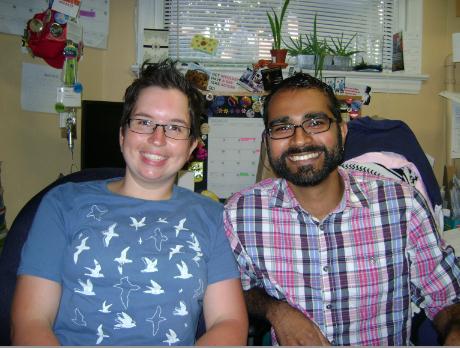Whether it’s the gay teen assured that condoms are the best way to prevent pregnancy or the trans girl who isn’t given the tools to cope with puberty, many queer and transgender youth find sexual health education to be an exercise in frustration, the place in the school curriculum where their experiences are perhaps most blatantly excluded.
Over the coming school year, however, Anna Penner and David Udayasekaran, of Planned Parenthood Toronto, will work to make sex ed just a little bit queerer, by developing a resource with and for lesbian, gay, bisexual, trans and queer youth.
“What we hope to achieve is a resource that queer and trans youth can look at and think, ‘This is relevant to me,’” Penner explains. It could be a zine, a video, a poster – they’re leaving that up to the youth who get involved.
“This project, at least for me, is quite personal,” says Penner, who recalls being told in past sex ed lessons, “You will go through puberty. You are going to start being attracted to boys.” She was then taught how to use a condom. When events didn’t unfold as promised, Penner found she had no resources to fall back on.
As she and Udayasekaran gear up for the project launch, they’re asking others to share their bad sex-ed stories. They’re interested not only in the classroom, but also in youths’ experiences with medical health providers and other adults who interact with and educate youth, and the stories have started to come in.
One student reported being asked on a quiz whether they’d be attracted to a) men or b) women when they grew up (and yes, there was a right answer).
They’ve also heard from several people who were advised by doctors that they didn’t need Pap tests unless they had sex with men (Planned Parenthood Toronto, in fact, is involved in a campaign encouraging queer women to get Pap tests). Most complaints, however, don’t seem to be about bad information, but an absence of information.
The two say there are, of course, serious consequences to the systemic exclusion of queer youth, and these extend beyond the oft-discussed issues of depression and teen suicide. In their Toronto Teen Survey, Planned Parenthood found that pregnancy rates are higher among queer youth than their peers, consistent with other research. According to their report, youth cited denial (eg attempts to prove that they are straight) and pressure to be straight among the causes.
Michael Erickson, a teacher with the Toronto District School Board (TDSB) believes the board has one of the strongest equity policies in the world, but at the same time, he agrees that there are major gaps in current sex education. “It is not uncommon for a student to go through 12 years of school and not have gay and lesbian sex properly explained or have the risks or benefits taught,” Erickson says. In some cases, it may not even be mentioned.
Ontario might have been in a very different place had the provincial government stood by a revised curriculum it released in early 2010. “The new curriculum we almost got was really amazing,” says j wallace, former GSA equity facilitator at the Halton District School Board. The revised curriculum included relatively detailed discussion of gender and sexual diversity. “It’s not perfect, but it was a huge leap from what was written under Harris in 1998,” wallace says.
Following backlash from some religious groups, however, the government backed away from the revisions, and the interim edition now posted on the Ministry of Education website is a thoroughly gutted version of the original 2010 document. Gender identity and sexual orientation remain only as passing mentions, embedded in longer lists of the types of diversity that must be respected. Even all references to genital anatomy have been removed.
Despite this, Erickson knows of teachers doing really cutting-edge work, though he thinks they’re the minority. “Teachers, at the end of the day, do care about their students,” Erickson says, “but we don’t always have the tools we need to do our job with excellence.” Erickson was one of the lead authors on the TDSB’s homophobia and heterosexism resource guide released last year. Still, he thinks most teachers would welcome additional resources, both to educate themselves and to pass along to their students.
Penner and Udayasekaran are excited to get started. “We’ve already had people emailing us saying they want to be part of our Youth Advisory Committee . . . and offering to help out if they can’t be part of the Youth Advisory Committee,” Penner says. They’ll hold their first meeting in September. In the meantime, they’ll be accepting your sex ed stories at the Queering Sex Ed Facebook page and through #badsexed on Twitter.

 Why you can trust Xtra
Why you can trust Xtra


